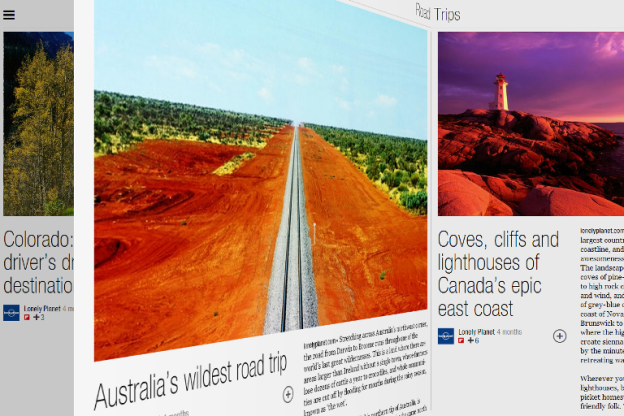 Yesterday Flipboard made its big leap from mobile-only to mobile-first: The wildly popular news reader application is now available via Web, bringing its sleek, beautiful algorithms to the desktop and a browser near you.
Yesterday Flipboard made its big leap from mobile-only to mobile-first: The wildly popular news reader application is now available via Web, bringing its sleek, beautiful algorithms to the desktop and a browser near you.
This is significant for a few reasons – partially because it gives Flipboard Magazine creators a wider audience, but mostly because it flies in the fact of the trendy “mobile-only” strategy that has many hot services like Instagram prioritizing mobile apps over an online presence. Is everything bound to end up on the desktop eventually?
Flipboard was one of the holdouts of the mobile-specific agenda, and clearly it’s making a concession by bringing its services to the browser. Of course, there are reasons aside to trying to reach more eyeballs: The giant hole left in our desktop’s lives by Google Reader is one that all news and reader applications should be trying to capitalize on. Google Reader was a legacy tool that met a very specific need and reader apps are clamoring to gain the users who’ve been abandoned by its demise – and Flipboard, which is on top of the mobile news reader and curator game, needs to have a Web presence in order to enter that specific fray.
Google Reader-replacement competition aside, Flipboard’s move to Web also challenges the concept that mobile-only applications are – or were – supposed to kill the desktop browser.
These mobile-first apps won’t show their whole deck, just a peek of usability to reel you in.
Instagram is an interesting case study of the mobile-only to mobile-first crossover. For the first two years of its existence, it was only accessible via mobile (and for much of that, iOS only), save for third party apps. After being bought by Facebook, the tip-toeing into desktop domain began: First, profile editing abilities and the simplest of viewing options; then Web profiles; this was followed by feeds, and most recently by the ability to embed photos and videos all over the Web.
Nearly everything you can do from the mobile app you can do from the Web app (you cannot upload, filter, and post content, so some things still are smartphone-sacred, nor is there a search and discovery feature). The ties with Facebook have obviously given Instagram-created content an extra boost on Web as well. A recent update to the Web version’s UI more closely aligned it with what we see on mobile as well, so there’s clearly an effort here to unify the app so that no matter whether you’re looking at your phone or sitting at your desk, you access one and only one Instagram experience.
And while you could argue that Path is a mobile-only hold out, the app relies on its pervasiveness because it’s pushed to so many other networks and lives on the Web through them – to be specific Facebook, Tumblr, Foursquare, and Twitter. Path is almost more like a beautiful, simplified management system for these social networks.

You can also do things like sign up for an account via desktop browser and change your settings, like your cover photo and profile picture, as well as alter notifications and connected accounts.
Now Flipboard joins these two with its first go at Web: The things you can’t do outnumber those you can, as with the previously mentioned two. You can read magazines and there are a handful of creation items … but of course, the remaining functionality – namely, search and discovery – remains mobile-only. Like Instagram and Path, Flipboard isn’t willing to give up all the mobile goodness it started with.

The lesson: If mobile usage is going well, adding desktop can only make it better – but only as a sort of precautionary, “for-the-time-being” agenda. And the enticements (and necessities) of still using the mobile app remain. These mobile-first apps won’t show their whole deck, just a peek of usability to reel you in.
Web on the desktop is safe – for now and probably for a very long time. It’s difficult, almost impossible, to imagine a corporate world where we can sit down and work without a desktop. It’s important to make a clarification here: There are many mobile-only apps that would make little or no sense on the desktop; for example gas price trackers, or apps that show where you car is parked, or apps primarily focused on location or on-the-go messaging. Your Tinders, Highlights, and WhatsApps don’t make a whole lot of sense on your desktop, so the mobile-only revolution will continue but for the moment it’s a specific one. It’s going to be populated by apps that would never have been created if the smartphone hadn’t been invented.
But for now, things like Flipboard still make too much damn sense on your computer screen, because they could have been created 10 years ago. Sure, they would have looked different, but they could have existed (and did in some early forms; Flickr was sort of like the Web’s Instagram predecessor). The concession you’ll have to make, however, is that while these tools may end up on the Web, they know the future is mobile – so don’t expect the full experience to come along for the ride.
Editors' Recommendations
- The T-Mobile Tuesdays app is about to get a big upgrade
- As Google’s first smartwatch, the Pixel Watch just doesn’t cut it
- T-Mobile’s 5G leads the pack in Ookla’s latest speed report
- iCloud doesn’t encrypt your data, but these cloud storage apps do
- T-Mobile becomes the first carrier to create a nationwide U.S. 5G network


